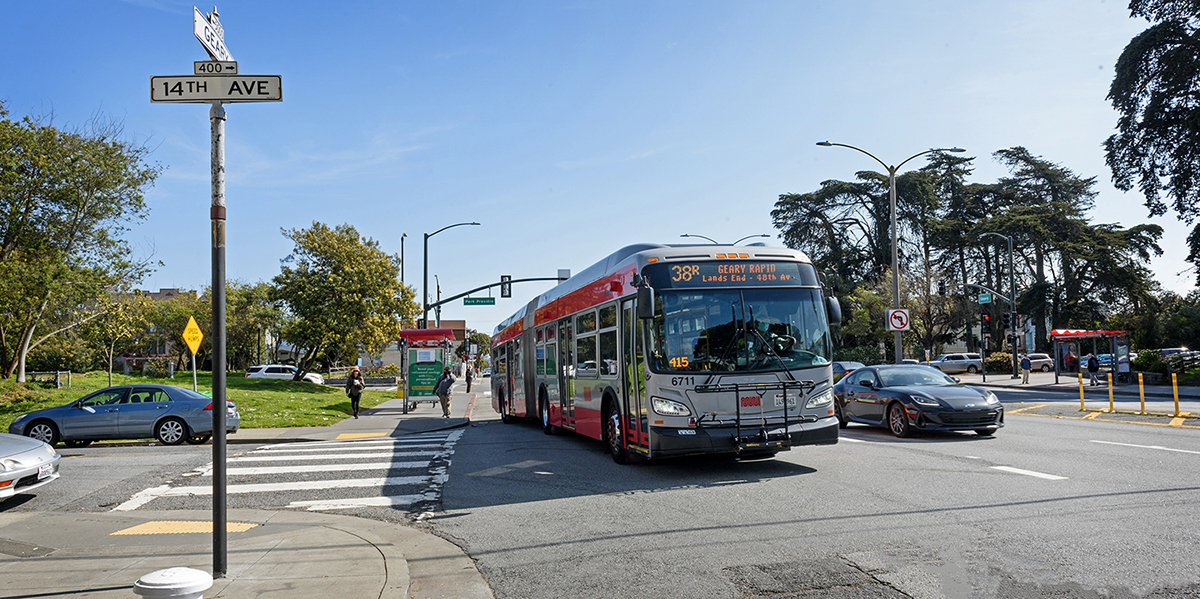
The SFMTA conducted two rounds of outreach in 2021 and 2022, hearing from hundreds of community members about their priorities for Geary Boulevard between Stanyan Street and 34th Avenue. In response to this input, we have made several design changes to the project. Review the final project proposals.
Next, the Geary Boulevard Improvement Project is planned to go before the SFMTA Board of Directors to be considered for approval. You may attend and provide public comment at the upcoming meeting, tentatively planned in May. More information will be shared about how to provide comments when the date has been confirmed. Learn more about the approvals process.
Some stakeholders have expressed concerns with the proposed conversion of angled parking to parallel parking to make room for a transit lane on blocks of Geary that do not yet have one. After further analysis, SFMTA staff continue to recommend converting angled parking to parallel due to the importance of improving transit performance in the corridor and to attract riders and support San Francisco’s pandemic recovery. Geary riders stand to save ~57,000 hours per year as a result of the project. However, given the level of interest in this topic, we will present two options to the SFMTA Board:
- Approve the project as recommended by SFMTA staff.
- Approve the project, but direct staff to delay some transit lane installation until the start of SFPUC water and sewer construction. Learn more.
Have questions? Contact us at ImproveGeary@SFMTA.com or 415.646.2300.
Why are more improvements needed on Geary?
Street space vs. street use: Over one third of people travel on Geary by bus, yet only 3% of the street is currently dedicated to transit between 15th and 25th avenues. If implemented, the project would better align the street space with how it’s used.

Sources: People in private vehicles = Pre-COVID traffic daily inbound volumes at Geary and 25th Avenue from Geary BRT EIR/EIS. People on Buses = SFMTA weekday load on 38 and 38R at Geary/25th Avenue in January/February 2020. Street space is estimated proportion of curb-to-curb space dedicated to transit (transit stops and transit lanes) vs. dedicated to general traffic (travel lanes, parking, loading).
Estimated travel time savings: If the project is implemented as proposed, the bus travel time savings can really add up for riders.
All time savings are calculated for riders traveling roundtrip between 33rd Avenue and Stanyan Street during rush hour. For a 38R Rapid rider traveling during rush hour, the savings would be: 4.3 minutes per day and 17.8 hours per year.
Safety: On average, one person walking within the project area is injured in a traffic collision each month. And WalkSF recently reported that, out of the ten most dangerous intersections in District 1, four of them are on Geary Boulevard. Some tools we have to improve safety include bulb-outs, enhanced median refuges, daylighting, larger traffic signals, and retiming signals to give people walking a head start to cross before vehicles. And because 40% of traffic deaths in San Francisco are caused by drivers making left turns, one of the project’s key safety proposals is to restrict 11 unprotected left turns. 
Environmental benefits: Private vehicles are among the largest contributors to greenhouse gases. When more people chose to take transit instead of driving because buses are quick and reliable, the benefits to the environment can be enormous.
Learn more about project benefits.
